Classifying enset based on their disease tolerance using deep learning
Downloads
Published
DOI:
https://doi.org/10.58414/SCIENTIFICTEMPER.2023.14.3.23Keywords:
Deep learning, VGG-19, VGG-16, Enset, CNN.Dimensions Badge
Issue
Section
License
Copyright (c) 2023 The Scientific Temper

This work is licensed under a Creative Commons Attribution-NonCommercial-ShareAlike 4.0 International License.
Even though agriculture remains the main source of Ethiopia’s population economy, not identifying enset based on their disease tolerance level is an obstacle for the production of enset.This paper’s main objective is to automatically identify the disease resistance levels of enset plants through digital image. The researcher followed the design science research method to achieve the objective listed above. Besides, the researcher has attempted to get valuable information about the type and the nature of these classes from the domain expert through interviews, document analysis, and observation from the fields. The total number of images used for experimentation purposes was 3000. The Contaharmonic filtering technique was implemented to remove noise due to its highest entropy recorded. A deep learning-based approach with training from scratch and transfer learning convolutional neural network methods were applied. Based on this, the researcher made experimentation for transfer learning by using two different pre-trained models, namely VGG-19 and VGG-16. Finally, the developed classifier model’s performance was assessed using accuracy, precision, recall, and the F1 score. According to the interpretation of the results, the proposed model’s training from scratch method achieves 92.6%. On the other way, the accuracy obtained with the transfer learning method, VGG-16 achieves 98.5%, and VGG-19 achieves 93.9%. Hence, transfer learning, specifically the VGG-16 model revealed an effective and robust performance for classifying enset based on their disease tolerance level based on the researcher’s number of images.Abstract
How to Cite
Downloads
Similar Articles
- Bhaskar Pandya, Pradipsinh Zala, Vocational education and lifelong learning: Preparing a skilled workforce for the future , The Scientific Temper: Vol. 15 No. spl-2 (2024): The Scientific Temper
- T. Ramyaveni, V. Maniraj, Hyperparameter tuning of diabetes prediction using machine learning algorithm with pelican optimization algorithm , The Scientific Temper: Vol. 15 No. 03 (2024): The Scientific Temper
- Fauzi Aldina, Yusrizal ., Deny Setiawan, Alamsyah Taher, Teuku M. Jamil, Social science education based on local wisdom in forming the character of students , The Scientific Temper: Vol. 14 No. 03 (2023): The Scientific Temper
- Balaji V, Purnendu Bikash Acharjee, Muniyandy Elangovan, Gauri Kalnoor, Ravi Rastogi, Vishnu Patidar, Developing a semantic framework for categorizing IoT agriculture sensor data: A machine learning and web semantics approach , The Scientific Temper: Vol. 14 No. 04 (2023): The Scientific Temper
- T. Kanimozhi, V. Rajeswari, R. Suguna, J. Nirmaladevi, P. Prema, B. Janani, R. Gomathi, RWHO: A hybrid of CNN architecture and optimization algorithm to predict basal cell carcinoma skin cancer in dermoscopic images , The Scientific Temper: Vol. 15 No. 02 (2024): The Scientific Temper
- Y. Mohammed Iqbal, M. Mohamed Surputheen, S. Peerbasha, A COVID Net-predictor: A multi-head CNN and LSTM-based deep learning framework for COVID-19 diagnosis , The Scientific Temper: Vol. 16 No. 03 (2025): The Scientific Temper
- R Prabhu, S Sathya, P Umaeswari, K Saranya, Lung cancer disease identification using hybrid models , The Scientific Temper: Vol. 14 No. 03 (2023): The Scientific Temper
- Sowmiya M, Banu Rekha B, Malar E, Assessment of transfer learning models for grading of diabetic retinopathy , The Scientific Temper: Vol. 14 No. 02 (2023): The Scientific Temper
- Azar Bagheri Masoudzade, Maryam Ebrahim Nezhad, Appraising social class dimensions on learning motivation of Iranian students: Family studies and their status in focus , The Scientific Temper: Vol. 15 No. 02 (2024): The Scientific Temper
- Bajeesh Balakrishnan, Swetha A. Parivara, E-HRM: Learning approaches, applications and the role of artificial intelligence , The Scientific Temper: Vol. 14 No. 04 (2023): The Scientific Temper
<< < 1 2 3 4 5 6 7 8 9 10 > >>
You may also start an advanced similarity search for this article.



